Two Japanese, one American win Nobel Prize in physics
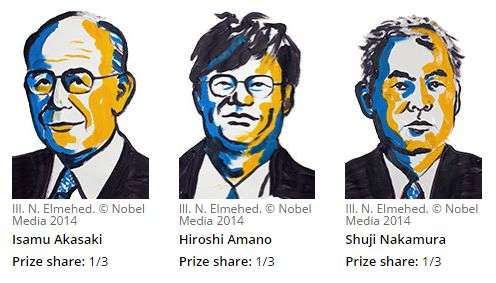
An invention that promises to revolutionize the way the world lights its homes and offices—and already helps create the glowing screens of mobile phones, computers and TVs— earned a Nobel Prize on Tuesday for two Japanese scientists and a Japanese-born American.
By inventing a new kind of light-emitting diode, or LED, they overcame a crucial roadblock for creating white light far more efficiently than incandescent or fluorescent bulbs. Now LEDs are pervasive and experts say their use will only grow.
"Incandescent light bulbs lit the 20th century; the 21st century will be lit by LED lamps," the Nobel committee said in announcing its award to Japanese researchers Isamu Akasaki and Hiroshi Amano and naturalized U.S. citizen Shuji Nakamura.
Their work, done in the early 1990s, led to a fundamental transformation of technology for illumination, the committee said. And when the three arrive in Stockholm to collect their awards in early December, "they will hardly fail to notice the light from their invention glowing in virtually all the windows of the city."
Nakamura, 60, is a professor at the University of California, Santa Barbara. Akasaki, 85, is a professor at Meijo University and Nagoya University in Japan, while Amano, 54, is also at Nagoya. Akasaki and Amano made their inventions while working at Nagoya, while Nakamura was working separately at the Japanese company Nichia Chemicals.
At a press conference, Nakamura said he is "happy to see that my dream of LED lighting has become a reality. Nowadays we can buy energy-efficient light bulbs in the supermarket and help reduce energy use. I hope this helps to reduce global warming too," he said, reading from a prepared statement.
Asked earlier if he realized the importance of his research early on, he told reporters, "Nobody can make a cellphone without ... my invention."
Akasaki told a nationally-televised news conference in Japan that he had faced skepticism about his research bearing fruit. "But I never felt that way," he said. "I was just doing what I wanted to do."
Amano said in an interview on NTV aired from Lyon, France on Wednesday that he credits Japan's high school and university systems for his win.
"To know that the ultimate purpose of education, or anything, is to do something to help people. That says it all," he said.
Before their work, scientists had long been able to produce red and green light with LEDs. But they needed a blue LED as well to make white light, a goal sought for about 30 years. The three new Nobel laureates created blue LEDs.
It's "a fundamental invention that is rapidly changing the way we bring light to every corner of the home, the street and the workplace," H. Frederick Dylla, the executive director and CEO of the American Institute of Physics, said in a statement.
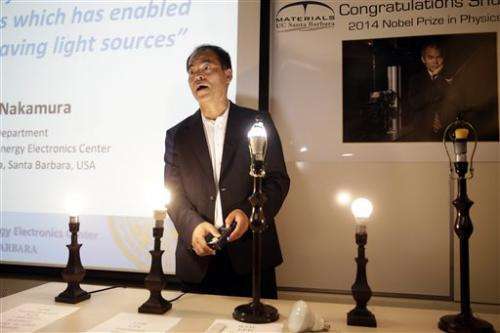
For illuminating schools, homes and offices, "it's quite possible this will change everything. All the light sources could easily become blue-LED-based light sources," said Mark Rea, director of the Lighting Research Center at the Rensselaer Polytechnic Institute in Troy, New York.
Nadarajah Narendran, director of research at the center, estimated the share of illumination by LED lights in homes, offices, streets and industries is approaching 10 percent in the United States. Within five years, he said, that fraction will probably exceed 30 percent as prices come down.
People can already buy LED lights for their homes at a fairly affordable price, he said.
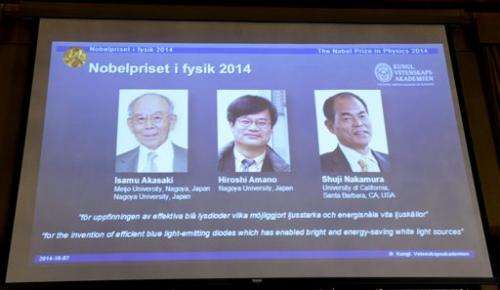
In poor countries, such lights are replacing alternatives like kerosene lanterns, he said.
"It's touched (people) from the poor to the rich in a very short time frame," he said.
The Nobel committee noted that for people not supplied by power grids, LED lamps may be feasible to use with cheap solar power because they consume so little energy.
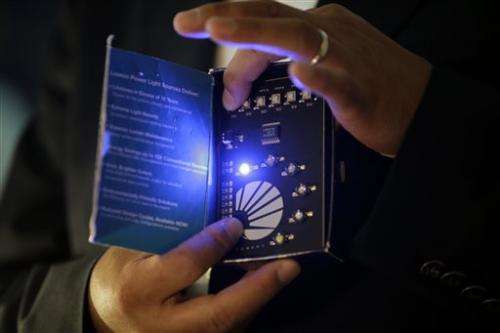
The committee also said the efficiency of LEDs helps save the Earth's resources because about one-fourth of world electricity consumption is used for lighting.
Not all reactions to the prize were laudatory. Many colleagues of Nick Holonyak Jr., a retired professor from the University of Illinois who invented the red LED in 1962, have long said his work was unjustly overlooked by the Nobel committee. In the past, Holonyak, now 85, has said the award was far less important to him than the work.
But on Tuesday, Holonyak said the work done by the new winners was built on achievements by himself and dozens of others who worked with him.
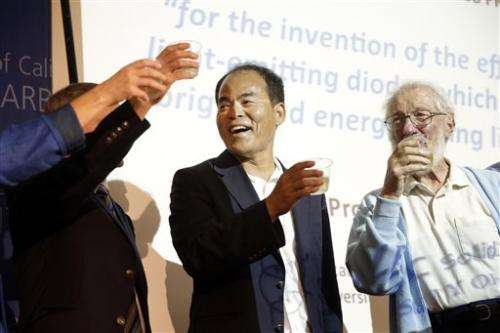
"I find this one insulting," he said in an interview in Urbana, Illinois.
Last year's physics award went to British scientist Peter Higgs and Belgian colleague Francois Englert for helping to explain how matter formed after the Big Bang.
On Monday, U.S.-British scientist John O'Keefe split the Nobel Prize in medicine with Norwegian couple May-Britt Moser and Edvard Moser for breakthroughs in brain research that could pave the way for a better understanding of diseases like Alzheimer's.
The Nobel award in chemistry will be announced Wednesday, followed by the literature award on Thursday, the Nobel Peace Prize on Friday and the economics prize on Monday.
Worth 8 million kronor ($1.1 million) each, the Nobel Prizes are always handed out on Dec. 10, the anniversary of prize founder Alfred Nobel's death in 1896. Besides the prize money, each laureate receives a diploma and a gold medal.

Nobel, a wealthy Swedish industrialist who invented dynamite, provided few directions for how to select winners, except that the prize committees should reward those who "have conferred the greatest benefit to mankind."
This year's physics prize, the Nobel committee said, was given with that idea in mind.
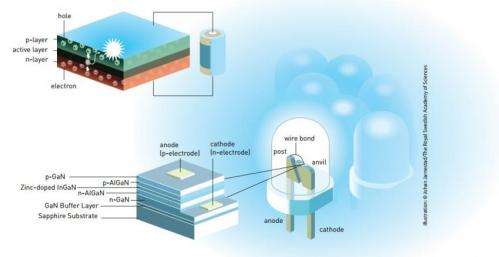
The Royal Swedish Academy of Sciences Announcement
The Royal Swedish Academy of Sciences has decided to award the Nobel Prize in Physics for 2014 to
— Isamu Akasaki
Meijo University, Nagoya, Japan and Nagoya University, Japan
— Hiroshi Amano
Nagoya University, Japan
and
— Shuji Nakamura
University of California, Santa Barbara, CA, USA
"for the invention of efficient blue light-emitting diodes which has enabled bright and energy-saving white light sources"
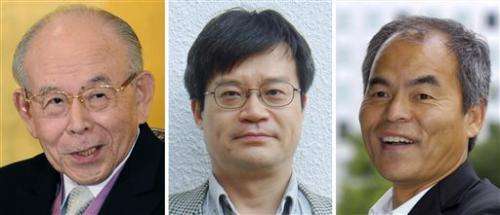
New light to illuminate the world
This year's Nobel Laureates are rewarded for having invented a new energy-efficient and environment-friendly light source – the blue light-emitting diode (LED). In the spirit of Alfred Nobel the Prize rewards an invention of greatest benefit to mankind; using blue LEDs, white light can be created in a new way. With the advent of LED lamps we now have more long-lasting and more efficient alternatives to older light sources.
When Isamu Akasaki, Hiroshi Amano and Shuji Nakamura produced bright blue light beams from their semi-conductors in the early 1990s, they triggered a funda-mental transformation of lighting technology. Red and green diodes had been around for a long time but without blue light, white lamps could not be created. Despite considerable efforts, both in the scientific community and in industry, the blue LED had remained a challenge for three decades.
They succeeded where everyone else had failed. Akasaki worked together with Amano at the University of Nagoya, while Nakamura was employed at Nichia Chemicals, a small company in Tokushima. Their inventions were revolutionary. Incandescent light bulbs lit the 20th century; the 21st century will be lit by LED lamps.
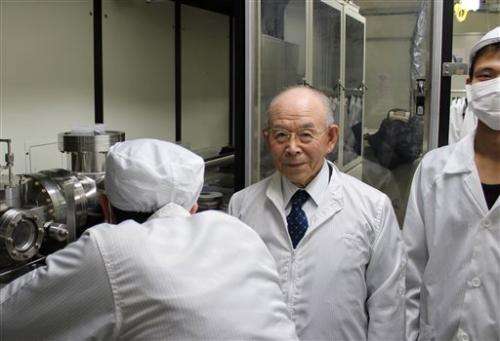
White LED lamps emit a bright white light, are long-lasting and energy-efficient. They are constantly improved, getting more efficient with higher luminous flux (measured in lumen) per unit electrical input power (measured in watt). The most recent record is just over 300 lm/W, which can be compared to 16 for regular light bulbs and close to 70 for fluorescent lamps. As about one fourth of world electricity consumption is used for lighting purposes, the LEDs contribute to saving the Earth's resources. Materials consumption is also diminished as LEDs last up to 100,000 hours, compared to 1,000 for incandescent bulbs and 10,000 hours for fluorescent lights.
The LED lamp holds great promise for increasing the quality of life for over 1.5 billion people around the world who lack access to electricity grids: due to low power requirements it can be powered by cheap local solar power.
The invention of the blue LED is just twenty years old, but it has already contributed to create white light in an entirely new manner to the benefit of us all.
More information: — www.nobelprize.org/nobel_prize … sics/laureates/2014/
— Scientific background: www.nobelprize.org/nobel_prize … physicsprize2014.pdf
© 2014 The Associated Press. All rights reserved.


















